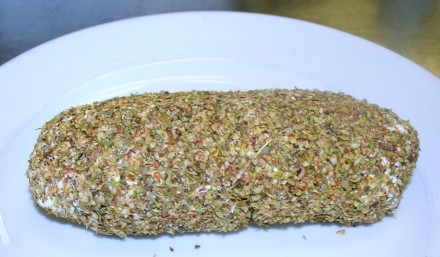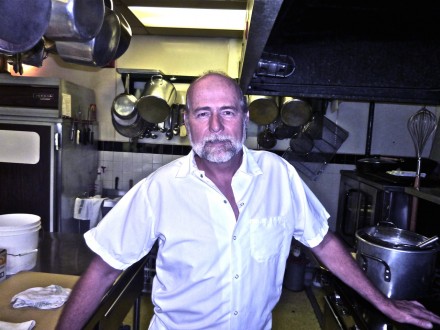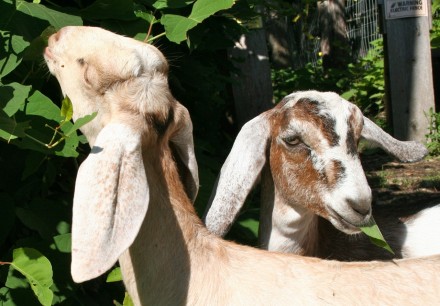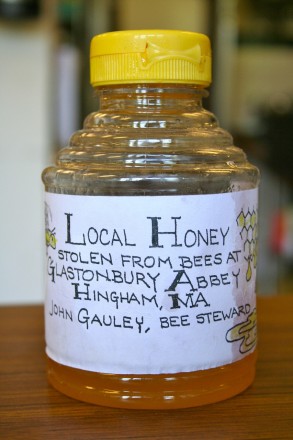I’m standing in the large kitchen at Hingham’s Glastonbury Abbey talking to its head cook, John Gauley, when Father Tom, one of the monastery’s 12 Benedictine monks, pops in. I’m glad because although I’m here to talk about the food Gauley makes, I don’t know what monks actually do and now I can ask.
Father Tom, who is a priest as well as a monk, has been at the abbey for 42 years, and Gauley, who lives in Cohasset, for 24.
Father Tom explains that among their other duties, the monks gather daily for Vigils at 6:30 a.m., Lauds 75 minutes later, a noon Mass, Vespers at dusk, and evening Compline.
“We spend a long time in prayer,” he says.
“Not long enough,” says Gauley, who has a quip for every word Father Tom utters.
The monk laughs easily, then tells me about the brothers’ three vows: stability, conversion of life, and obedience.
“See, they have to tolerate me, it’s one of their vows,” says Gauley, who considers himself a Pagan.
As the cook checks the temperature of a pot of goat milk on the stove (he’s making cheese), I ask Father Tom, out of Gauley’s earshot, how his cooking is.
“Monks from other monasteries want to stay here because of the food,” he answers. “We are very fortunate to have him.”
“Blessed,” corrects Gauley, who, apparently, has very good hearing.
In this case, the cook’s jest hits the mark: I think blessed is the right word.
Gauley loves what he does, and goes above and beyond: He bakes fresh bread daily from a sour dough starter he keeps in a bucket in the walk-in (focaccia, oatmeal cranberry, multigrain); has been making his own honey for nearly two decades (300 pounds last year); and has begun, this year, to produce fresh chevre from the milk of the small herd of Nubian goats he began raising two years ago.
In all, there are five buildings on the magnificent 60-plus acre site, including a conference center which hosts hundreds of group meetings throughout the year. Along with the monk’s meals, Gauley, and his assistant, Ben Laney, cook for these events as well.
Not only that, but Gauley donates his time to prepare the Sunday Supper the Abbey provides for anyone needing a meal on the last Sunday of the month. Gauley also cooks a main course once a month that the monks take to Father Bill’s homeless shelter. And – when there’s extra – he sells his honey in the Abbey bookstore.
Seeing how Gauley runs the kitchen with dedication, routine, and a sense of service, I comment to Father Tom that Gauley is, in fact, rather monk-like himself.
“He is,” says Father Tom. “We’ve tried to get him to join the community, but he’s anti-this, and anti-that. We love him anyway — and his cooking. Although I wish he wouldn’t forget things: he makes these delicious things then forgets how he did it.”
Which is how Gauley likes to cook. Less by rote than by feel and daily inspiration. The goat cheese, however, requires very exacting measures quite unlike his usual creative approach.
“It has to be pasteurized in a water bath to 160 degrees and cooled to 90 degrees… cheese is a lot more complicated than I thought,” says Gauley, who’s become quite expert on both cheese making and goat husbandry. It’s clear he likes the challenge, though, and his various chevres (one is herb-covered) are delicious: creamy, mild, and slightly zingy.
“This has been a learning year for the cheese,” he says.
Gauley’s eight goats live in a series of shacks and pens on an idyllic woodsy, rocky hillside 100-plus yards from the kitchen. He’s milking only one this season – Abby. Milked twice daily, she provides about three quarts a day. With this, Gauley makes cheese once a week, getting about four pounds from what is about five gallons.

The kitchen is the warm center of the monastery, with monks and volunteers running in and out of it delivering the big dishes Gauley cooks – or simply serving their brothers at table daily. It’s a nourishing, nurturing shelter of a place: a lively, light-filled room in the monastery adjacent to the bookstore and the rectory.
When I ask Father Tom if he has a favorite dish of Gauley’s, it is Gauley who answers.
“It’s a raw vegetable salad,” he says.
“Actually, it is,” says Father Tom. “I love that.”



